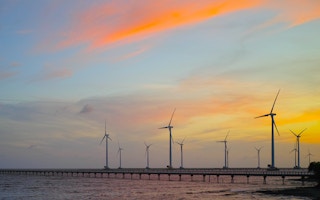Hãy đọc câu chuyện này bằng tiếng Việt
Singapore’s electricity regulator has given tentative approval for plans to import 1.2 gigawatts (1.2 GW) of primarily wind-generated electricity from Vietnam, Southeast Asia’s renewable energy powerhouse.
The latest conditional approval – given to power import projects preliminarily found to be technically and commercially viable – comes after similar authorisations for a 1 GW import plan from Cambodia and 2 GW from Indonesia earlier in the year.
The projects would total 4.2 GW of power imports, just exceeding Singapore’s target to bring in 4 GW of low-carbon electricity from neighbouring countries by 2035. The capacity represents around 30 per cent of the city-state’s projected power needs that year.
The Vietnam power import venture, involving Singapore’s Sembcorp Utilities and Vietnam’s state-owned PetroVietnam Technical Services Corporation, includes the laying of subsea power cables spanning around 1,000 kilometres between the two countries.
Sembcorp said the Vietnam offshore wind farms could start operating by 2033 subject to approvals and barring unforeseen events. It did not state when it expects to start piping electricity to Singapore.
Dr Tan See Leng, manpower minister and second minister for trade and industry, said at the Singapore International Energy Week event that the city-state is exploring taking in more electricity imports, taking into account energy security and cost considerations.
Singapore’s Energy Market Authority (EMA) had received over 20 proposals since it started soliciting applications in 2021, including from consortiums looking to import hydropower from Sarawak, and solar power from Northern Australia.
An EMA spokesperson said the agency “remains open to receiving good proposals from the industry”, will continue discussions with companies that have submitted proposals, and engage the governments of source countries where necessary.
It is not immediately clear if the remaining projects can expect to import power into Singapore before 2035, a requirement for submitting the proposals to EMA.
Tim Anderson, president-director of Sun Cable Indonesia, said the firm would continue to engage with EMA, with whom he said it has a good working relationship.
Sun Cable had submitted a request to the agency last year to send solar power from Darwin, Australia to Singapore via a 4,300 kilometre undersea cable, but later entered administration as its main owners sparred over the feasibility of the ambitious cable project. The project resumed in September under Grok Ventures, one of the two owners.
Anderson said the firm intends to continue helping with Singapore’s commitment to reaching net-zero emissions by 2050, and has a target to supply electricity to the city-state by 2035.
“We wait with interest to see what EMA decides to do,” Anderson added.
Malaysia’s Sarawak Energy, one of the partners behind the plan to send hydropower from Sarawak state in Malaysia to Singapore, declined to comment. Singapore newspaper The Straits Times reported last month that Sarawak Energy intends to provide 1 GW of electricity to Singapore by 2032.
Singapore sees power imports as one of its main future sources of clean energy, along with others such as domestic solar panels and clean hydrogen fuel.
EMA awarded its first gigawatt-scale conditional approval to utility firm Keppel Energy in March, for transmitting solar, hydro and potentially wind power from Cambodia to the city-state.
In September, it granted conditional approvals to five projects looking to send primarily solar power from Indonesia to Singapore, with commercial operations slated to start by 2027.
Solar power is expected to be the dominant source of renewable energy in the import projects Singapore has issued conditional approvals for.
Dr David Broadstock, senior research fellow and energy transition lead at the National University of Singapore’s Sustainable and Green Finance Institute, noted Singapore’s optimism with energy imports.
Broadstock pointed to Tan, the Singapore minister, saying Singapore will be able to meet its 4 GW import target “when”, and not “if”, the projects are implemented.
Following the conditional approvals this year, the power import consortiums will need to clear at least two more regulatory hurdles in Singapore alone before construction work can start – getting conditional licences after further studies and engagements with host countries are done, and earning the importer license after achieving financial close.
It is also important that Singapore adequately develops frameworks for flexible cross-border electricity trade, as the scale of power transfers in the coming years will increase dramatically, Broadstock said.
As it stands, the country has a small 100-megawatt hydropower import trial with Laos, with the electricity sent through power lines in Thailand and Malaysia. About 270 gigawatt-hours have been imported, corresponding to about 0.5 per cent of Singapore’s 2022 power consumption.
Laos, Thailand, Malaysia and Singapore are now discussing trading power at capacities beyond 100 MW and sending electricity in multiple directions, Tan said.
Tan added that Singapore hopes its power import projects can support the development of a broader Southeast Asian power grid, an ambitious plan mooted in the 1990s that has been slow to materialise.
A study on the regional power grid by Singapore and the United States is expected to show that energy interconnections can reduce greenhouse emissions, lower capital costs, increase power supply resilience and create more green jobs, Tan shared.

















